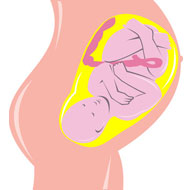- Baby care
- Baby Crying
- Baby Feeding
- Baby Growth
- Baby Language
- Baby Name
- Baby Potty Training
- Baby Safety
- Baby Shower
- Baby Sleep
- Baby Teething
- Bathing a Baby
- Early Pregnancy Signs
- Late Pregnancy
- Miscarriage
- Molar Pregnancy
- Post Pregnancy
- Postpartum Depression
- Pre Pregnancy
- pregnancy care
- Pregnancy Conditions
- Pregnancy Diet
- Pregnancy Due Date
- Pregnancy Exercise
- Pregnancy Heartburn
- Pregnancy Sex
- Pregnancy Sleep
- Pregnancy Stages
- Pregnancy Stretch Marks
- Pregnancy Style and Fashion
- Preschooler
- Second Pregnancy
- Teen Pregnancy
- Toddler Activities
- Toddler Behavior
- Toddler Discipline
- Toddler Food
- Toddler Illness and Injuries
- Toddler Speech
- Twin Pregnancy
Placenta Praevia During Pregnancy

Placenta previa is a condition wherein the placenta partially or completely covers the cervix during pregnancy. One sign of placenta previa is bleeding in the last trimester of gestation. In this case, the bleeding will be painless.
Another indication of placenta previa could be a uterus that's much larger than it should be in the trimester. At times placenta previa also causes early contractions.
Placenta previa could be total, marginal, partial or even low-lying in nature. Total placenta previa happens when the placenta completely covers the cervical os.
Marginal placenta is when the placenta is on the edge of the os. Partial placenta previa, as the name implies, occurs when the placenta covers a part of the os and low-lying placenta is indicated by placenta implantation in the lower uterus. In this case the placenta is very close to the os but it doesn't quite touch it.
Placenta previa can be diagnosed during an ultrasound. In quite a few pregnancies, previa, complete, partial or otherwise is detected during the second trimester but more than ninety-five percent of the time these are resolved by the third trimester. Doctors usually determine the seriousness of placenta previa in the third trimester through a follow up ultrasound. However, having placenta previa at the end of the gestation period could lead to health complications for the mother as well as the baby.
For a baby it could lead to blood loss and chances of congenital abnormalities. For the mother, placenta previa could lead to severe hemorrhage post delivery as well as chances of placenta accreta. This is a condition wherein the placenta is stuck to the uterus muscle. Also, often placenta previa results in cesarean delivery.
Since placenta previa often triggers bleeding, particularly, in the third trimester, the expectant mother diagnosed of this condition is put on immediate bed rest. If the bleeding is too severe and is not controlled with medication, doctors usually do a C-section, even if the gestational term is not complete. If placenta previa happens early in the third trimester, the mother may also be given steroid shots to help the baby's lung growth.
A few factors that might trigger placenta previa for a woman could be a previous injury in the uterus, getting pregnant soon after a cesarean delivery, smoking, abortion in the past and even multiple gestations.
If a woman is diagnosed with placenta previa, there is no immediate need to panic, as most often bed rest and diligent medication can sort this out quite effectively.
- RSS Feeds -
- All posts
- All comments
- Third Trimester Complications As you enter the last stage of your pregnancy, you may notice that many of ph
- Anterior Placenta In Pregnancy You go for an ultrasound and you are unable to see your baby. Your doctor s
- 13 Weeks Pregnant And Bleeding Bleeding occurs more commonly during the first trimester of pregnancy. There
- Bleeding in Early Pregnancy If you get vaginal bleeding during your early pregnancy, then you should repo